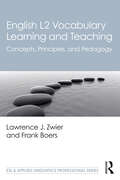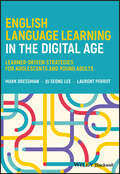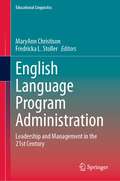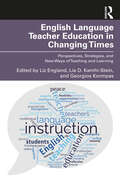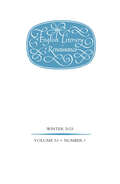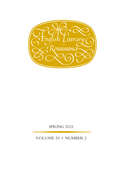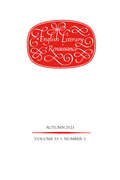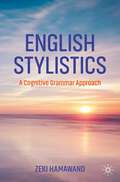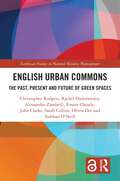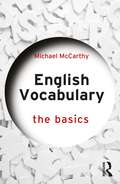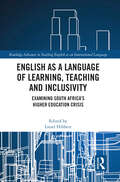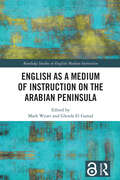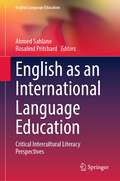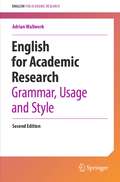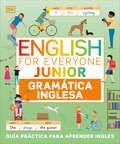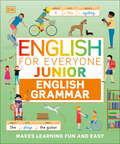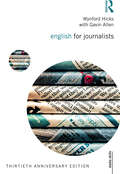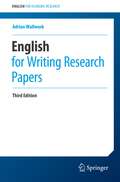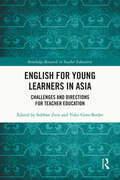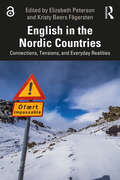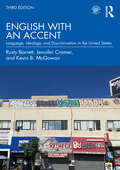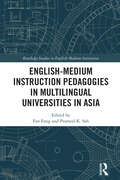- Table View
- List View
English L2 Vocabulary Learning and Teaching: Concepts, Principles, and Pedagogy (ESL & Applied Linguistics Professional Series)
by Lawrence J. Zwier Frank BoersAccessible to experts and non-experts alike, this text is a comprehensive entry to teaching and learning vocabulary in ESL and EFL contexts. Firmly grounded in research, it presents frameworks and methods for teaching vocabulary to English L2 speakers. Overviewing key topics as well as providing in-depth research analyses and critiques, Zwier and Boers address all major areas of vocabulary pedagogy and instruction. Organized in four parts, chapters cover the nature of vocabulary and strands of vocabulary research; curricular approaches; and techniques and activities. Readers are introduced to key topics, including teaching multiword expressions, assessment, discourse, and instruction at different levels. Each chapter includes questions, prompts, and activities to foster discussion. A foundational textbook for courses on L2 instruction and teacher-training courses, it is an essential text for students and scholars in TESOL and Applied Linguistics, and provides the pedagogical grounding future English L2 teachers need to effectively teach vocabulary.
English Language Learning in the Digital Age: Learner-Driven Strategies for Adolescents and Young Adults
by Mark Dressman Ju Seong Lee Laurent PerrotENGLISH LANGUAGE LEARNING IN THE DIGITAL AGE ‘The Digital Age has transformed our learning, particularly for adolescents and young adults. This book puts forward innovative methods and observations from which both teachers and students could greatly benefit in the Digital Age. As such, this is a much needed and timely book. I strongly recommend it to all who are interested in language learning.’ —Jieun Kiaer, University of Oxford ‘The authors have created a thoroughly documented, research-based, practical toolkit for 21st-century English language educators worldwide, using compelling storytelling and interactive suggestion. I would use it for teacher training in a flash.’ —Denyze Toffoli, Université Paul Sabatier Toulouse III, IUT-A English Language Learning in the Digital Age is a comprehensive introduction to the theoretical background and real-world application of IDLE (Informal Digital Learning of English). Designed for teachers and future teachers preparing to teach English as a second or other language, this highly practical guide focuses on incorporating digital technology into curricula to draw upon the extracurricular exposures to English that many students experience outside of the classroom. With some creativity and care, teachers can find ways to bring these experiences with English into the classroom, ultimately improving student learning outcomes. Offering a specific focus on examples and case studies drawn from language education in the Middle East, Asia, and Europe, this text employs a three-part structure beginning with the theories behind autonomous learning and the importance of informal language learning for young adults. Part two demonstrates various methods for integrating games, social media, e-books, language software, mobile apps, and other digital resources into the classroom. The third section addresses the use of IDLE methods to bridge the gap between informal and formal uses of English, the advantages and disadvantages of IDLE in flipped classrooms and online teaching, and how IDLE strategies can enhance mandated curricula and better prepare students for national exams. The book concludes with a brief discussion of the future of language learning and the need to include digital technologies and learner-driven strategies in education policy. English Language Learning in the Digital Age is an ideal textbook for upper-level undergraduate and graduate students in the fields of language education and language acquisition, as well as teachers and teachers-in-training who are preparing to teach English in countries where English is not the primary language.
English Language Program Administration: Leadership and Management in the 21st Century (Educational Linguistics #59)
by MaryAnn Christison Fredricka L. StollerThis volume provides both practicing and aspiring Language Program Administrators with knowledge about the research and theory that underpin key topics in educational leadership, as well as practical guidance for the day-to-day management of language programs, including budgets, personnel, decision making, strategic planning, advocacy, and digital technologies. The volume brings together 46 authors and contributors with a vast array of experiences as administrators of English language teaching programs all over the world—in Asia; Australia; Europe; the Middle East; New Zealand; North, Central, and South America; South Africa; Turkey; and the United Kingdom. As the need for more qualified administrators and leaders has increased, more teacher education programs have added formal courses on leadership and program administration to their offerings. Educators teaching these courses will find this volume to be an excellent core text to support students in developing their knowledge of and skills for language program administration. All chapters are connected to the contemporary realities of language program administration, and they offer practical guidance to Language Program Administrators in ways that are adaptable to different administrative contexts globally.
English Language Teacher Education in Changing Times: Perspectives, Strategies, and New Ways of Teaching and Learning
by Liz England Lía D. Kamhi-Stein Georgios KormpasThis volume addresses challenges that the field of English language teacher education has faced in the past several years. The global pandemic has caused extreme stress and has also served as a catalyst for new ways of teaching, learning, and leading. Educators have relied on their creativity and resiliency to identify new and innovative teaching practices and insights that inform the profession going forward. Contributors describe how teacher educators have responded to the specific needs and difficulties of educating teachers and teaching second language learners in challenging circumstances around the world and how these innovations can transform education going forward into the future. Paving the way for a revitalized profession, this book is essential reading for the current and future generations of TESOL scholars, graduate students, and professors.
English Literary Renaissance, volume 53 number 1 (Winter 2023)
by English Literary RenaissanceThis is volume 53 issue 1 of English Literary Renaissance. English Literary Renaissance (ELR) is a leading journal for new research in Tudor and Stuart literature, including the Sidneys, Spenser, Shakespeare, Jonson, Donne, Milton, and their many contemporaries. In addition to critical work, ELR also publishes review essays and occasional editions of short significant manuscripts, such as letters, legal documents with literary relevance, and poetry.
English Literary Renaissance, volume 53 number 2 (Spring 2023)
by English Literary RenaissanceThis is volume 53 issue 2 of English Literary Renaissance. English Literary Renaissance (ELR) is a leading journal for new research in Tudor and Stuart literature, including the Sidneys, Spenser, Shakespeare, Jonson, Donne, Milton, and their many contemporaries. In addition to critical work, ELR also publishes review essays and occasional editions of short significant manuscripts, such as letters, legal documents with literary relevance, and poetry.
English Literary Renaissance, volume 53 number 3 (Autumn 2023)
by English Literary RenaissanceThis is volume 53 issue 3 of English Literary Renaissance. English Literary Renaissance (ELR) is a leading journal for new research in Tudor and Stuart literature, including the Sidneys, Spenser, Shakespeare, Jonson, Donne, Milton, and their many contemporaries. In addition to critical work, ELR also publishes review essays and occasional editions of short significant manuscripts, such as letters, legal documents with literary relevance, and poetry.
English Medium Instruction as a Local Practice: Language, culture and pedagogy (SpringerBriefs in Education)
by Jinghe HanFrom the perspective of translanguaging and instruction theories, this Open Access book examines Chinese English Medium Instruction (EMI) lecturers’ linguistic and pedagogical characteristics. This book demonstrate that ‘English’ in EMI is not a monolingual issue and EMI lecturers have applied their bilingual advantages to systematically and strategically advance their pedagogy practices through a translanguaging process. This book reflects upon EMI lecturers’ culture-imbedded teaching and learning philosophies and explores the implications of local classroom practices, such as topic-centered instruction and teacher presentation through demonstration. This book argues that EMI teaching is not an approach that can reach universal consent across linguistic, cultural and educational systems; it is an approach that is exclusively contextualised in the lecturers’ closely related cultural and educational system, and restricted by the available resources.This is an open access book.
English Stylistics: A Cognitive Grammar Approach
by Zeki HamawandThis accessible textbook hinges on the central assumptions of Cognitive Linguistics and Cognitive Grammar, introducing students to the analytical tools they need to approach Stylistics, an essential area in language analysis. The author verifies the claim that alterations in style, triggered by different cognitive processes, reflect alterations in meaning, and shows how they are employed to achieve particular effects in context. The book links theory with practice, aiming both to acquaint students with the cognitive principles that account for stylistic expressions, and to provide them with the tools and techniques to conduct their own analyses. The textbook explores and explains how writers use the resources of language to create meaning, and how readers interpret texts. It will be of interest to advanced undergraduate and postgraduate students on courses in English Linguistics, as well as those working on other languages and in related areas such as Composition and Creative Writing.
English Urban Commons: The Past, Present and Future of Green Spaces (Earthscan Studies in Natural Resource Management)
by Sarah Collins Rachel Hammersley Christopher Rodgers Emma Cheatle Olivia Dee Alessandro Zambelli John Wedgwood Clarke Siobhan O’NeillThe book presents a novel examination of urban commons which provides a robust base for education initiatives and future public policy guidance on the protection and use of urban commons as invaluable urban green spaces that offer a diverse cultural and ecological resource for future communities. The book's central argument is that only through a deep understanding of the past and a rigorous engagement with present users, can we devise new futures or imaginaries of culture, well-being and diversity for the urban commons. It argues that understanding the genesis of, and interactions between, the different pressures on urban green space has important policy implications for the delivery of nature conservation, recreational access and other land use priorities. The stakeholders in today’s urban commons, whether land users, policy makers or the public, are the inheritors of a complex cultural legacy and must negotiate diverse and sometimes conflicting objectives in their pursuit of a potentially unifying goal: a secure future for our urban commons. The book offers a unique and strongly interdisciplinary study of urban commons, one that brings together original historical investigation, contemporary legal scholarship, extensive oral history research with user groups, and research examining the imagined futures for the urban common in modern society. It explores the complex social and political history of the urban common, as well as its legal and cultural status today, using four diverse case studies from within England as exemplars of the distinctively urban common. These are Town Moor in Newcastle, Mousehold Heath in Norwich, Clifton and Durdham Downs in Bristol and Valley Gardens in Brighton. The book concludes by looking forward and considering new tools and methods of negotiation, inclusivity and creativity to inform the future of these case studies, and of urban commons more widely. This book will be of great interest to students and scholars of the commons, green spaces, urban planning, environmental and urban geography, environmental studies and natural resource management.
English Vocabulary: The Basics (The Basics)
by Michael McCarthyEnglish Vocabulary: The Basics offers a clear, non-jargonistic introduction to English vocabulary, the way linguists classify and explain it, and the place of vocabulary in our overall picture of the language, and in society. Introducing a range of terminology for discussing vocabulary, the reader is provided with a coherent, structured description of what we know about words and their meanings. Key features of this book include: • Analysis of historical roots of present-day words • Coverage of the differences between speech and writing and between formality and informality • Understanding of the social implications of choices that readers make to use standard or non-standard (e.g., regional/dialect) vocabulary • A focus on British English with reference to a wide range of varieties of English that include North American English, Irish English, Indian English, Malaysian English, Nigerian English and Caribbean English. Featuring a glossary of key terms, cartoons and illustrations, further reading, reflection points, interesting "factoids" and examples from corpora from around the world, this book is an engaging and thought-provoking read for anyone with an interest in English vocabulary.
English as a Language of Learning, Teaching and Inclusivity: Examining South Africa’s Higher Education Crisis (Routledge Advances in Teaching English as an International Language Series)
by Liesel HibbertHibbert explores South Africa’s higher education crisis utilising case studies and first-hand experiences with English as the language of instruction. The historical overview provides a framework with which to understand the complicated nature of using English as a language of instruction in South Africa, past and present. Student narratives are presented to illustrate mainly breakthroughs, but also challenges. An overview is provided, of imported English teaching methodologies and how they have emerged and developed in the local educational system over decades. It is demonstrated how these methodologies relate to socio-economic and political events and trends at each juncture. By applying defamiliarisation as a research method of investigation, students’ translanguaging struggles are recorded and discussed, both pre-pandemic and in the pandemic period. The experiences of non-monolingual English-speaking staff and students, and of local English/African language bilinguals is foregrounded, as they are by far the majority in South African higher education and schools. The relevance of the experiences and learning paths of those staff and students is enhanced. This book aids lecturers across disciplines and English language facilitators in the improvement of English acquisition curricula through exposure to arguments, case studies and learning path narratives in this volume, and prompts and inspires researchers to develop further theories and experiments in their own context.
English as a Medium of Instruction on the Arabian Peninsula (Routledge Studies in English-Medium Instruction)
by Mark Wyatt Glenda El GamalFocusing on English as a Medium of Instruction (EMI) in the Arab Gulf states, the authors consider both sociolinguistic and pedagogical perspectives, and explore practical implications. This edited volume features chapters covering how teachers are negotiating the linguistic challenges posed by EMI; issues of ownership, choice and agency; the scaffolding of academic literacies; how to support the development of content teachers’ pedagogical content knowledge in EMI settings as well as the benefits of a bilingual education. Chapter authors all have extensive local experience that they draw upon reflectively in their writing. Policy-makers, teachers and teacher educators wondering how they can best balance the need to develop competence in English in students of all ages on the Arabian Peninsula in a globalizing world, together with the concern to nurture Arabic language, culture and identity, will gain rich insights from this book. Postgraduates and researchers exploring issues surrounding EMI, both locally and internationally, will benefit from the arguments presented in this volume.
English as an International Language Education: Critical Intercultural Literacy Perspectives (English Language Education #33)
by Ahmed Sahlane Rosalind PritchardThis volume provides an overview of current issues in English as an International Language (EIL) education and critical intercultural literacy pedagogy. The different chapters are inspired by ‘critical interculturality’ as a decolonial project that seeks to interrogate the structures, conditions, and mechanisms of colonial power relations that still pervade our increasingly globalising postcolonial societies; they tend to perpetuate forms of discrimination such as sexism, racism, classism, heterosexism and linguicism. Divided into five sections, this collection critically examines English Language Teaching textbooks’ integration of intercultural dimensions, the promotion of intercultural literacy in teacher education programs, the management of cultural diversity in multicultural professional/business and educational situations, and the ‘decolonisation’ of the curriculum in various global educational and professional situations. The book presents a range of linguistic approaches as a means of examining the nature of intercultural communication pertaining in EIL varied international contexts. The chapters also reflect a wide diversity of perspectives from local contexts with global relevance and applicability. This book is an indispensable reference for business leaders, international relations stakeholders, education and linguistics students, educationists, textbook designers, teacher trainers and researchers of language and culture, critical pedagogy, multiculturalism studies, TESOL and English as a lingua franca (ELF).
English class 4 - GSTB New 2023
by Gujarat Secondary and Higher Secondary Education Boardપ્રસ્તુત પુસ્તક દ્વારા વિદ્યાર્થીઓને ગમતી પ્રવૃત્તિઓનો સમાવેશ કરીને હસતાં રમતાં અંગ્રેજી આવડે તેવો પ્રયાસ છે. અહીં Story, Action Songs, Games અને Activities દ્વારા બાળકો સહજતાથી અંગ્રેજીનો પરિચય કેળવશે.
English class 8 - Tamil Nadu Board
by State Council of Educational Research and Training Tamil NaduThe English textbook for standard VIII, designed per the National Curriculum Framework 2005, aims to make learning English both effective and enjoyable. It balances teaching the language's structures and vocabulary with practical usage in everyday life, ensuring a comprehensive and engaging learning experience.
English for Academic Research: Grammar, Usage and Style (English for Academic Research)
by Adrian WallworkThis guide draws on English-related errors from around 6000 papers written by non-native authors, 500 abstracts written by PhD students, and over 2000 hours of teaching researchers how to write and present research papers. This new edition has chapters on exploiting AI tools such as ChatGPT, Google Translate, and Reverso, for generating, paraphrasing, translating and correcting texts written in English. It also deals with contemporary issues such as the use of gender pronouns. Due to its focus on the specific errors that repeatedly appear in papers written by non-native authors, this manual is an ideal study guide for use in universities and research institutes. Such errors are related to the usage of articles, countable vs. uncountable nouns, tenses, modal verbs, active vs. passive form, relative clauses, infinitive vs. -ing form, the genitive, link words, quantifiers, word order, prepositions, acronyms, abbreviations, numbers and measurements, punctuation, and spelling. Other titles in this series: Grammar, Vocabulary, and Writing Exercises (three volumes) 100 Tips to Avoid Mistakes in Academic Writing and Presenting English for Writing Research Papers English for Presentations at International Conferences English for Academic Correspondence English for Interacting on Campus English for Academic CVs, Resumes, and Online Profiles English for Academic Research: A Guide for Teachers Adrian Wallwork is the author of more than 40 English Language Teaching (ELT) and English for Academic Purposes (EAP) textbooks. He has trained several thousand PhD students and researchers from 50 countries to write papers and give presentations. He edits research manuscripts through his own proofreading and editing service.
English for Everyone Junior Gramática inglesa (DK English for Everyone Junior)
by DKAyuda a los niños a aprender las reglas de la gramática inglesa con este divertido libro ilustrado.Esta guía de gramática incluye ilustraciones atractivas, diseños claros y explicaciones sencillas de las reglas del inglés redactadas de una manera fácil de entender para niños de 5 a 9 años. Cada regla gramatical va acompañada de una explicación sencilla que servirá tanto a padres como a profesores a la hora de ofrecerles apoyo a los niños. Además, muestra a través de ilustraciones escenarios del día a día para que los pequeños estudiantes vean la aplicabilidad del contenido.En su interior, encontrarás:-Gramática básica para niños que comenzaron a estudiar inglés recientemente, como los tiempos verbales, oraciones afirmativas, negativas o interrogativas, verbos modales, pronombres y adjetivos.-Las estructuras gramaticales y lingüísticas que necesitan aprender para la preparación de los exámenes Cambridge Young Learners o los grados 1, 2 y 3 de los exámenes Trinity GESE-Módulos cortos, explicaciones sencillas y bonitas ilustraciones que hacen que la gramática sea fácil de entender.El enfoque visual y dinámico de English for Everyone Junior: English Grammar sin duda cautivará a los estudiantes más jóvenes, ¡y se convertirá en su compañero de estudio ideal! Acompañales a descubrir el mundo que los rodea, a hablar sobre lo que les gusta y lo que no, a hacer preguntas, a formar oraciones negativas ¡y mucho másLa colección English for Everyone de DK es una forma fácil y divertida de aprender inglés. Con audios de apoyo e innovadores ejercicios que cubren todos los aspectos clave del idioma, estos libros ilustrados sustituyen complicadas explicaciones por imágenes y gráficos claros, para aprender visualmente y que la gramática y el vocabulario resulten fáciles de recordar. ¡Aprender inglés no ha sido nunca tan fácil!Understand the rules of English grammar with this fun, fully illustrated reference book for children aged 5–9 who are studying English as a foreign language. This ultimate grammar guide features attractive illustrations, clear layouts, and simple explanations that present and explain the rules of the English language in a way that is easy for younger learners to understand and digest. The grammar covered in this reference guide will help children aged 5-9 to describe the world around them, talk about their likes and dislikes, ask questions, and form negative sentences. Grammar is first presented in a realistic scene, and then broken down into bite-size chunks that are easy to understand and digest. Each grammar rule is accompanied by a simple explanation that can be used by the teacher or parent. This grammar book for children offers: -Material that’s ideal for children who have recently begun to study English, covering essential grammar including present, past, and future tenses, negatives, questions, modal verbs, pronouns, and adjectives.-The grammar and language structures required for the Cambridge Young Learners exams or Grades 1–3 of the Trinity GESE exams.-Bite-sized modules that make grammar easy to understand, clear and simple explanations, and beautiful illustrations.Young learners of English will be captivated and engaged by the dynamic visual approach that sets English for Everyone Junior: English Grammar apart from other language materials for children. This Engish grammar guide is the ideal companion for children who have recently begun to study English, including those preparing for the Cambridge Young Learners exams or Grades 1–3 of the Trinity GESE exams.
English for Everyone Junior English Grammar: A Simple Visual Guide to English (DK English for Everyone Junior)
by DKUnderstand the rules of English grammar with this fun, fully illustrated reference book for children aged 5–9 who are studying English as a foreign language. This ultimate grammar guide features attractive illustrations, clear layouts, and simple explanations that present and explain the rules of the English language in a way that is easy for younger learners to understand and digest. The grammar covered in this reference guide will help children aged 5-9 to describe the world around them, talk about their likes and dislikes, ask questions, and form negative sentences. Grammar is first presented in a realistic scene, and then broken down into bite-size chunks that are easy to understand and digest. Each grammar rule is accompanied by a simple explanation that can be used by the teacher or parent. This grammar book for children offers: - Material that&’s ideal for children who have recently begun to study English, covering essential grammar including present, past, and future tenses, negatives, questions, modal verbs, pronouns, and adjectives.- The grammar and language structures required for the Cambridge Young Learners exams or Grades 1–3 of the Trinity GESE exams.- Bite-sized modules that make grammar easy to understand, clear and simple explanations, and beautiful illustrations.Young learners of English will be captivated and engaged by the dynamic visual approach that sets English for Everyone Junior: English Grammar apart from other language materials for children. This Engish grammar guide is the ideal companion for children who have recently begun to study English, including those preparing for the Cambridge Young Learners exams or Grades 1–3 of the Trinity GESE exams. More in the seriesIf you like English for Everyone Junior: English Grammar then why not try English for Everyone Junior: My First English Dictionary, as part of the widely successful English for Everyone Junior Series, which have sold more than two million copies in over 90 countries.
English for Journalists: Thirtieth Anniversary Edition (Media Skills)
by Wynford Hicks Gavin AllenEnglish for Journalists has established itself in newsrooms the world over as an invaluable guide to the basics of English and to those aspects of writing, such as reporting speech, house style and jargon, which are specific to the language of journalism. Written in a highly accessible and engaging style, English for Journalists covers the fundamentals of grammar, spelling, punctuation and journalistic writing, with all points illustrated through a series of concise and illuminating examples. The book features practical, easy-to-follow advice with examples of common mistakes and problem words. This thirtieth anniversary edition features a revised first chapter on the state of English today by author Wynford Hicks, and a chapter on writing for social media by Gavin Allen, along with an updated glossary and references. This is an essential guide to written English for practising journalists and students of journalism today.
English for Writing Research Papers (English for Academic Research)
by Adrian WallworkPublishing your research in an international journal is key to your success in academia. This guide is based on a study of over 1000 manuscripts and reviewers' reports revealing why papers written by non-native researchers are often rejected due to problems with English usage and poor structure and content. With easy-to-follow rules and tips, and examples taken from published and unpublished papers, you will learn how to: prepare and structure a manuscriptincrease readability and reduce the number of mistakes you make in English by writing concisely, with no redundancy and no ambiguitywrite a title and an abstract that will attract attention and be readdecide what to include in the various parts of the paper (Introduction, Methodology, Discussion etc)highlight your claims and contributionavoid plagiarismdiscuss the limitations of your researchchoose the correct tenses and stylesatisfy the requirements of editors and reviewers This edition has two completely new chapters covering machine translation and using AI tools (e.g. chatbots, paraphrasers, editing tools) to improve and correct the English of a text. Other titles in this series: Grammar, Usage and Style Grammar, Vocabulary, and Writing Exercises (three volumes) 100 Tips to Avoid Mistakes in Academic Writing and Presenting English for Presentations at International Conferences English for Academic Correspondence English for Interacting on Campus English for Academic CVs, Resumes, and Online Profiles English for Academic Research: A Guide for TeachersAdrian Wallwork is the author of more than 40 English Language Teaching (ELT) and English for Academic Purposes (EAP) textbooks. He has trained several thousand PhD students and researchers from 50 countries to write papers. He edits research manuscripts through his own proofreading and editing agency.
English for Young Learners in Asia: Challenges and Directions for Teacher Education (Routledge Research in Teacher Education)
by Subhan ZeinIn the first book to concentrate on teacher education for English for young learners (EYL) teachers in Asia, Zein and Butler offer a comprehensive coverage of teacher education by addressing various issues and recent developments such as programme evaluation, knowledge base, practicum, classroom discourse, needs analysis, and policy on teacher education. The world’s rapidly changing political, social, economic, and educational landscapes in the 21st century have been distinctively characterized by an increasing number of children who are learning English globally at younger ages. This book tackles the challenges and complexities surrounding teacher education by examining the policies and practices of primary English language teacher education in a variety of educational contexts, namely Bangladesh, China, Indonesia, Japan, Kazakhstan, Thailand, and South Korea. Using a variety of data collection methods like interviews, reflective journals, and questionnaires, the content delves into the different strategies and initiatives that have been implemented or proposed to improve teacher education. A vital read for academics and students in the fields of early language learning, Teaching English to Speakers of Other Languages (TESOL), Applied Linguistics, Educational Linguistics, English Language Education, and comparative education studies, as well as teacher educators aiming to advance the teaching of English in Asia and beyond.
English in the Nordic Countries: Connections, Tensions, and Everyday Realities
by Elizabeth Peterson Kristy Beers FägerstenPeople in the Nordic states – Norway, Sweden, Finland, Denmark, and Iceland – rank as among the most proficient speakers of English in the world. In this unique volume, international experts explore how this came to be, what English usage and integration looks like in different spheres of society and the economy in these countries, and the implications of this linguistic phenomenon for language attitudes and identity, for the region at large, and for English in Europe and around the world. Led by Elizabeth Peterson and Kristy Beers Fägersten, contributors provide a historical overview to the subject, synthesize the latest research, illustrate the roles of English with original case studies from diverse communities and everyday settings, and offer transnational insights critically and in conversation with the situation in other Nordic states. This comprehensive text is the first book of its kind and will be of interest to advanced students and researchers of World/Global Englishes and English as a lingua franca, language contact and dialect studies/language varieties, language policy, multilingualism, sociolinguistics, and Nordic/Scandinavian and European studies.
English with an Accent: Language, Ideology, and Discrimination in the United States
by Rusty Barrett Jennifer Cramer Kevin B. McGowanSince its original publication in 1997, English with an Accent has inspired generations of scholars to investigate linguistic discrimination, social categorization, social structures, and power. This new edition is an attempt to retain the spirit of the original while enriching and expanding it to reflect the greater understanding of linguistic discrimination that it has helped create. This third edition has been substantially reworked to include: An updated concept of social categories, how they are constructed in interaction, and how they can be invoked and perceived through linguistic cues or language ideologies Refreshed accounts of the countless social and structural factors that go into linguistic discrimination Expanded attention to specific linguistic structures, language groups, and social domains that go beyond those provided in earlier editions New dedicated chapter on American Sign Language and its history of discrimination QR codes linking to external media, stories, and other forms of engagement beyond the text A revamped website with additional material English with an Accent remains a book that forces us to acknowledge and understand the ways language is used as an excuse for discrimination. The book will help readers to better understand issues of cross-cultural communication, to develop strategies for successful interactions across social difference, to recognize patterns of language that reflect implicit bias, and to gain awareness of how mistaken beliefs about language create and nurture prejudice and discrimination.
English-Medium Instruction Pedagogies in Multilingual Universities in Asia (Routledge Studies in English-Medium Instruction)
by Pramod K. Sah Fan FangThis collection brings together perspectives from emerging and established scholars, working from empirical data from real-life classroom experiences, to investigate pedagogical issues in the application of EMI across a range of educational contexts in Asia. Drawing on research across different levels of education covering institutions across various contexts across Asia, the book engages in key questions around power, marginalization, attitudes, intercultural communication, and identity construction as they unfold in classrooms in which a plurality of languages and varieties of English collide and are mediated, appropriated, and accommodated. The volume explores the pedagogical challenges, policies, and practices of EMI which emerge in these settings, highlighting real-life problems in EMI program development and the wider pedagogical implications for EMI implementation in varied educational environments. Taken together, the chapters offer opportunities for further research toward challenging traditionally held beliefs and blind implementation of EMI and encouraging critical perspectives from both researchers and policymakers alike. Pedagogies of English-Medium Instruction Programs in Asian Universities will be of interest to scholars and practitioners in English-medium instruction, English language teaching, TESOL, and applied linguistics.
